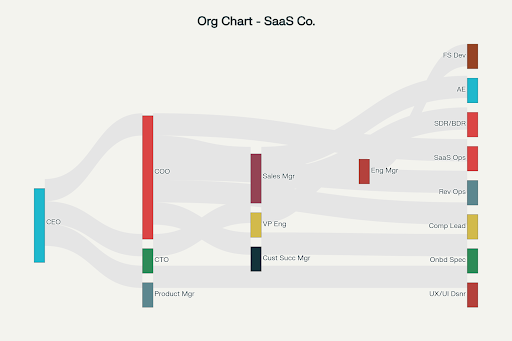The Complete Guide To SaaS Roles And Operations In 2025
- Pooja Pandit

- Jul 31
- 13 min read
Updated: Aug 26

There is a strong shift in mindset: SaaS, Software as a Service, is no longer just a product.
It’s an operating model. Running a SaaS company requires systemized roles, structured processes, and strategic operations, not just building software, and hence, a strong SaaS recruitment strategy.
As companies scale, so does the complexity of their teams, titles, and tools. Yet most orgs still struggle with SaaS roles.
SaaS roles aren’t defined and have constant ambiguity across functions.It has misaligned operations that surely slow down the growth.And, last but not least, the hiring based on hype, not structure.eNavigating through the wants and needs of an SaaS organization is the most challenging thing when it comes to SaaS roles.
This is a definitive resource for founders, operators, and SaaS professionals shaping the future of software.
This guide brings clarity. Whether you’re hiring your first product lead or redefining operations at $50M ARR, you'll find practical definitions, org charts, KPIs, and modern best practices to build teams that scale with your software.
Understanding the SaaS Company Org Chart and SaaS Roles


A strong SaaS company needs to be built on clearly defined pillars. These pillars are the ones that carry the weight of building the product that can scale and generate revenue for the company. Below, we break down the major departments and their must-have roles, so your talent sourcing becomes easier to navigate.
Executive & Leadership
CEO
As the chief visionary and leader, the CEO steers the entire SaaS organization toward long-term growth, sets cultural standards, and builds trust with stakeholders and investors.
Core Responsibilities:
Define and articulate the company vision and mission.
Develop and implement growth strategies, including new markets and product lines.
Build, maintain, and champion a strong organizational culture.
Lead investor communications and manage stakeholder relationships.
Represent the company at major industry events and in the press.
Key KPIs:
Annual recurring revenue (ARR) growth rate.
Customer acquisition and retention rates.
Net promoter score (NPS) for the overall brand.
Employee engagement and satisfaction index.
Fundraising success (new capital raised, valuation increase).
The churn rate of both customers and talent.
Salary range of SaaS CEO
Region | Average SaaS CEO Salary | Range (most typical cases) | Notes |
|---|---|---|---|
US | $320k–$346k | $100k–$900k+ | IPO/later-stage; startup avg ~$161k |
Europe | €168k ($183k)–€1.57M | €130k–€1.9M+ base | Startups €168k, public cos €1.5M+ |
India | ₹32.5L (~$39k) | ₹10L–₹96L ($12k–$115k) | Top CEOs >₹1Cr ($120k+), rare cases higher |
For all salary ranges in the blog -
US/UK roles frequently incorporate On-Target Earnings (OTE), combining base salary and commissions/bonuses.
India figures are in lakhs (L), where 1L = 100,000 INR; leadership roles often negotiate bonuses and equity.
Entry: up to 3 years’ experience | Mid: 3–7 years | Senior: 7+ years.
Ranges reflect broad benchmarks; actual compensation may vary by company size, location, and negotiable perks.
COO
The COO drives operational excellence at scale, ensuring every function works together efficiently and processes are optimized for seamless delivery and rapid company growth.
Core Responsibilities:
Oversee all aspects of operational scaling (people, processes, systems).
Optimize and standardize cross-functional processes for efficiency.
Ensure cross-departmental alignment and collaboration.
Monitor operational metrics and drive continuous improvement.
Oversee cost control and budget adherence in operations.
Identify and remove operational bottlenecks.
Key KPIs:
Gross and net margin improvement.
Efficiency ratios (revenue per employee, cost per customer served).
Operational SLA adherence.
Process automation and cycle time reductions.
Customer support and onboarding turnaround times.
Cross-functional project delivery rate.
Salary range for COO
Region | Entry | Mid | Senior |
|---|---|---|---|
US | $120,000–$180,000 | $180,000–$300,000 | Up to $550,000+ |
UK | £90,000–£120,000 | £120,000–£160,000 | Up to £240,000+ |
India | ₹15L–₹30L | ₹30L–₹60L | Up to ₹2Cr+ |
CTO
The CTO provides technical leadership, defines the product and technology vision, and ensures systems are secure, scalable, and aligned with the company’s business goals.
Core Responsibilities:
Design and maintain robust, scalable technical architecture.
Own and execute the technology/product roadmap.
Ensure delivery of high-quality, secure, and reliable products.
Oversee data strategy, security, and compliance.
Empower, build, and develop the engineering team.
Evaluate and implement emerging technologies.
Key KPIs:
Product uptime/reliability (SLA adherence).
Time to market for new features/releases.
Defect rate and resolution time.
Security incident frequency and response time.
Infrastructure cost optimization.
Technical debt metrics (e.g., % of resources on legacy vs. new development).
Salary range of a CTO/VP Technology
Region | Entry | Mid | Senior |
|---|---|---|---|
US | $180,000–$220,000 | $220,000–$350,000 | Up to $500,000+ |
UK | £120,000–£160,000 | £160,000–£250,000 | Up to £400,000+ |
India | ₹30L–₹45L | ₹45L–₹60L | ₹60L–₹150L |
Product, Engineering, and UX

VP Engineering
The VP of Engineering leads the technical team, setting standards for excellence in hiring, code quality, and delivery velocity to ensure robust product output and technical scalability.
Responsibilities:
Build and scale high-performing engineering teams through effective technical hiring.
Establish and enforce rigorous code quality standards and review processes.
Drive development velocity by optimizing team workflows and resource allocation.
Collaborate cross-functionally to align engineering with business and product goals.
Mentor engineering leaders and foster continuous technical improvement.
KPIs:
Time-to-hire for key engineering roles.
Code review scores or defect escape rates.
Sprint or release velocity metrics.
Engineering retention rate.
Percentage of projects delivered on schedule.
Salary range of VP Engineering in the US
Level | Salary Range | Notes |
Entry | $180,000–$220,000 | Small startups, first-time or early-stage VPs |
Mid | $220,000–$300,000 | Growth-stage SaaS, strong experience/team leadership |
Senior | $300,000–$500,000+ | Large/later-stage SaaS, high-profile or public firms; some can exceed $500,000 with bonuses/equity |
Engineering Manager
Engineering Managers oversee project delivery and develop engineering talent, balancing day-to-day execution with team growth and performance.
Responsibilities:
Manage day-to-day delivery oversight for one or more development teams.
Perform regular performance reviews and provide continuous feedback.
Remove bottlenecks and ensure impediments to progress are swiftly addressed.
Foster a culture of accountability, collaboration, and technical excellence.
Track and report progress on deliverables and goals.
KPIs:
On-time project/feature delivery rate.
Individual and team performance improvement scores.
Frequency and quality of one-on-one meetings.
Team satisfaction/engagement index.
Unresolved blockers or escalation frequency.
Salary range of an Engineering Manager in the US
Level | Salary Range | Notes |
Entry | $130,000–$170,000 | Small SaaS startups, new managers, early in their management career. |
Mid | $170,000–$220,000 | Experienced engineering managers, growing SaaS firms, strong team leadership. |
Senior | $220,000–$300,000+ | Large/later-stage SaaS, big team/complex product, or high-profile roles. |
Full-stack Developer
Full-stack Developers are responsible for building, debugging, and scaling application features, contributing directly to product quality and user experience.
Responsibilities:
Develop and deploy new features across the frontend and backend.
Debug and resolve code or performance issues efficiently.
Ensure solutions are scalable, maintainable, and meet performance targets.
Collaborate closely with product and design teams for seamless delivery.
Write tests and documentation as part of the deliverable code.
KPIs:
Number of features shipped per quarter.
Bug resolution time and reopened bug rate.
Code coverage and test quality metrics.
System throughput and latency benchmarks.
Pull request review turnaround time.
Salary range of a Full-stack developer in the US
Level | Salary Range | Typical Notes |
|---|---|---|
Entry | $80,000–$120,000 | 0–2 years’ experience, small SaaS/startup, or new to full-stack role |
Mid | $120,000–$180,000 | 2–5 years, established SaaS, strong skills and/or team contributors |
Senior | $180,000–$300,000+ | 5+ years, late-stage/startup leads, principal/architect, big tech hubs |
Product Manager
Product Managers champion the voice of the customer, driving the prioritization and definition of product features to maximize business and user impact.
Responsibilities:
Identify customer pain points and synthesize them into actionable insights.
Prioritize features and initiatives based on business value and user need.
Define clear product requirements and success metrics.
Align cross-functional teams around product goals and delivery timelines.
Monitor product performance and iterate based on user feedback.
KPIs:
Feature adoption metrics and usage statistics.
Customer satisfaction/NPS for shipped features.
Percentage of roadmap items delivered on time.
Time from ideation to production for key features.
Churn rate attributed to product fit.
Salary range of a Product Manager
Region | Entry | Mid | Senior |
US | $90,000–$110,000 | $110,000–$140,000 | $140,000–$200,000 |
UK | £55,000–£70,000 | £70,000–£110,000 | £110,000–£150,000 |
India | ₹20L–₹35L | ₹35L–₹55L | ₹55L–₹75L |
UX/UI Designer
UX/UI Designers translate user needs and business goals into intuitive wireframes, interactive prototypes, and polished interfaces, focusing on usability and seamless user experience.
Responsibilities:
Craft wireframes, user flows, and high-fidelity prototypes for new features.
Conduct usability testing and incorporate findings into design iterations.
Collaborate with product, engineering, and stakeholders to ensure alignment.
Establish and maintain design systems and style guides.
Advocate for accessibility and inclusive design throughout the product.
KPIs:
Usability test improvement scores.
Time to deliver core design assets for major features.
User engagement and conversion rates post-launch.
Developer implementation cycles (revision rate).
Accessibility compliance score.
Salary range of a UI/UX Designer
Region | Fresher (Entry) | Mid-Level | Senior |
|---|---|---|---|
US | $70,000–$100,000 | $100,000–$155,000 | $155,000–$225,000+ |
UK | £28,000–£38,000 | £38,000–£60,000 | £60,000–£85,000+ |
India | ₹3.5L–₹6L | ₹6L–₹15L | ₹15L–₹30L+ |
Sales, Revenue, and Customer

Sales Manager
The Sales Manager leads the sales team, setting targets, forecasting the pipeline, and ensuring consistent achievement of revenue goals.
Responsibilities:
Set and communicate team sales targets and quotas.
Forecast pipeline and manage sales performance metrics.
Coach, mentor, and develop the sales team to achieve objectives.
Analyze trends and adjust strategies to maximize revenue.
Collaborate with marketing, product, and customer success teams.
KPIs:
Quota attainment rate (team).
Sales pipeline coverage ratio.
Win rate (team-wide).
Average sales cycle length.
Team retention and engagement scores.
Salary range of Sales Manager
Region | Entry | Mid | Senior |
|---|---|---|---|
US | $80,000–$110,000 | $110,000–$150,000 | Up to $200,000 (OTE) |
UK | £40,000–£60,000 | £60,000–£95,000 | Up to £140,000 (OTE) |
India | ₹6L–₹15L | ₹15L–₹25L | ₹25L–₹112L |
Account Executive (AE)
Account Executives are responsible for closing new deals and developing account strategies to drive revenue growth from new and existing customers.
Responsibilities:
Manage the full sales cycle from prospecting to contract closure.
Develop and execute targeted account strategies for key prospects and customers.
Conduct product demonstrations and negotiate pricing and terms.
Maintain accurate CRM records and sales forecasting.
Collaborate with customer success for smooth handoff and ongoing growth.
KPIs:
Closed-won deals per quarter.
Average deal size.
Win rate (individual).
Pipeline value (owned accounts).
Sales quota attainment (individual).
Salary range of Account Executive
Region | Entry | Mid | Senior |
|---|---|---|---|
US | $75,000–$95,000 | $100,000–$130,000 | Up to $240,000 (OTE) |
UK | £60,000–£80,000 | £90,000–£110,000 | £120,000–£200,000 (OTE) |
India | ₹8L–₹15L | ₹15L–₹25L | ₹25L–₹40L |
Salary range of Account Executive Manager
Region | Entry | Mid | Senior |
|---|---|---|---|
US | $110,000–$140,000 | $140,000–$160,000 | Up to $450,000 (OTE) |
UK | £80,000–£110,000 | £110,000–£150,000 | Up to £300,000 (OTE) |
India | ₹15L–₹30L | ₹30L–₹60L | ₹60L–₹100L |
SDR/BDR
Sales Development Representatives (SDRs) or Business Development Representatives (BDRs) focus on cold outreach and lead qualification to generate pipeline for the sales team.
Responsibilities:
Conduct outbound calls, emails, and social outreach to generate new leads.
Qualify inbound and outbound leads using defined criteria.
Set meetings for Account Executives with qualified prospects.
Maintain up-to-date lead records in the CRM.
Provide feedback to marketing on lead quality and messaging effectiveness.
KPIs:
Number of qualified meetings booked.
Leads generated per month.
Conversion rate from lead to opportunity.
Activity metrics (calls, emails, outreaches).
Pipeline attribution (value sourced).
Salary Range for BDR
Region | Entry | Mid | Senior |
|---|---|---|---|
US | $50,000–$60,000 | $60,000–$70,000 | Up to $80,000 (OTE) |
UK | £35,000–£45,000 | £45,000–£60,000 | Up to £70,000 (OTE) |
India | ₹5L–₹8L | ₹8L–₹12L | ₹12L–₹18L |
Salary range of SDR
Region | Entry | Mid | Senior |
|---|---|---|---|
US | $90,000–$110,000 | $110,000–$120,000 | Up to $160,000 (OTE) |
UK | £60,000–£75,000 | £75,000–£100,000 | Up to £120,000 (OTE) |
India | ₹10L–₹15L | ₹15L–₹25L | ₹25L–₹40L |
Customer Success Manager
Customer Success Managers ensure customers achieve value, driving renewals, retention, and net revenue retention (NRR).
Responsibilities:
Build and maintain strong relationships with assigned customers.
Drive customer engagement, product adoption, and satisfaction.
Manage the renewal process, identify expansion and upsell opportunities.
Analyze health scores and proactively address risks.
Serve as the voice of the customer internally.
KPIs:
Renewal rate.
Net revenue retention (NRR).
Customer satisfaction score (CSAT or NPS).
Adoption and engagement metrics.
Churn rate (logo and revenue).
Salary range of a Customer Success Manager
Region | Fresher/Entry | Mid-Level | Senior |
|---|---|---|---|
US | $62,000–$80,000 | $80,000–$110,000 | $110,000–$150,000+ |
UK | £28,000–£40,000 | £40,000–£60,000 | £60,000–£85,000+ |
India | ₹5L–₹8L | ₹8L–₹18L | ₹18L–₹30L+ |
Onboarding Specialist
Onboarding Specialists guide new customers through setup, activation, and key usage milestones to ensure a successful launch and early value realization.
Responsibilities:
Coordinate and lead onboarding sessions for new customers.
Assist with technical setup and integration.
Establish and guide customers through activation and key early milestones.
Track onboarding progress and resolve blockers quickly.
Educate and empower new users for self-sufficiency.
KPIs:
Time to first value (activation).
Onboarding completion rate.
Customer satisfaction post-onboarding.
Product adoption metrics in the first 30/90 days.
Onboarding NPS.
Operations: The Growth Backbone
SaaS Operations
SaaS Operations manages the company’s software tool stack, ensuring efficient application usage and governance throughout the organization.
Responsibilities:
Oversee the discovery, procurement, and management of all SaaS applications.
Manage comprehensive inventories of SaaS tools, documenting instances and users.
Automate onboarding/offboarding of employees to ensure secure and swift access changes.
Conduct regular license usage audits to identify underutilized or redundant subscriptions.
Enforce cost controls by monitoring usage, forecasting renewals, and optimizing SaaS spending.
Collaborate with IT, security, and business teams to implement best practices for SaaS adoption and data protection.
Educate users on application usage and new tools.
KPIs:
Time required for onboarding/offboarding each user.
% of SaaS licenses unused or underutilized.
Total SaaS spend per employee.
Quarterly reduction in redundant or unnecessary subscriptions.
Time to remediate and secure access after employee departures.
Number of audit findings or compliance exceptions regarding the SaaS stack.
Revenue Operations
Revenue Operations (RevOps) aligns sales, marketing, and customer support by driving data integrity, process optimization, and technology across the customer lifecycle.
Responsibilities:
Design and maintain unified data pipelines to ensure analytics accuracy and reporting consistency.
Ensure CRM systems are accurate, up-to-date, and structured for easy reporting and automation.
Align sales, marketing, and customer support processes to deliver a seamless customer experience.
Forecast revenue and analyze performance across channels.
Support the implementation and integration of marketing automation and customer data platforms.
Oversee performance tracking and process optimization for consistent growth.
KPIs:
CRM data accuracy (% of duplicate, incomplete, or out-of-date records).
Pipeline forecast accuracy (variance between forecasted and actual revenue).
Marketing and sales alignment score (joint campaigns, qualified leads passed, etc.).
Time to generate reports and business insights.
Sales cycle length and conversion rates across channels.
Revenue growth driven by automation/process improvements.
Compliance Lead
A Compliance Lead ensures the organization meets all security standards and regulatory obligations relating to data privacy, industry certifications, and customer trust.
Responsibilities:
Define, implement, and monitor security and privacy frameworks to align with regulations such as SOC2, GDPR, and HIPAA.
Develop and maintain compliance policies, procedures, and documentation.
Conduct regular internal and external audits to validate adherence to security controls.
Educate employees about compliance risks and standards; provide ongoing training.
Liaise with auditors, legal counsel, and regulatory bodies during audits and investigations.
Identify, assess, and mitigate compliance and security risks throughout the company.
Manage remediation plans for identified gaps and report on compliance status to leadership.
KPIs:
% of compliance gaps remediated within the defined SLA.
Number of audit findings (internal and external) per year.
Time to resolve compliance issues or security incidents.
Employee completion rate for compliance training programs.
Number of security/privacy incidents reported versus resolved.
Maintenance of active certifications (SOC2, GDPR, HIPAA) with no lapses.
Salary ranges of various SaaS operations roles in the US regions
Role/Level | Typical Salary Range | Average Salary | |
|---|---|---|---|
Operations Manager (SaaS) | $41,000–$77,500 | $63,456 | 25th–75th percentile; top earners up to $108,500. |
Operations Manager (SaaS startups) | $54,000–$237,000 | $109,694 | In leading startup/tech hubs, $115,000 is common. |
General Operations Manager | $38,000–$274,000 | $95,377 | Not SaaS-specific but a strong market reference. |
Director of SaaS Operations | $136,480–$240,876 | $240,876 | Top markets or larger firms go higher; some reports up to $350,000. |
How SaaS roles evolve with growth: Why timing is everything

In SaaS, timing your hires to match your growth curve is just as critical as making the right hire. Unlocking the next level of recurring revenue isn’t about hiring more; it’s about hiring differently at each inflection point.
As ARR climbs, the scrappy all-hands-on-deck mindset gives way to precision roles and layered expertise. Specializations emerge not in isolation, but as a seamless extension of your evolving org DNA.
1. Startup Stage ($0–$100K ARR)
Operating Mode: Hustle, improvisation, creative chaos
Org Reality: Everyone is a generalist. Founders code, sell, support, whatever it takes. Roles blend, boundaries blur.
Key Roles:
Founder
Full-stack Developer
Generalist Support
Specialization:
None. The focus is survival. Creativity thrives in ambiguity. Wins are shared, not siloed.
2. Early Growth ($100K–$2M ARR)
Operating Mode: Focused traction and first layering of structure
Org Reality: You’re gaining momentum. Time to delegate with intent. AEs come in to close deals. CSMs guard renewals and spot expansion. PMs start herding product priorities.
Key Roles:
Account Executive (AE)
Customer Success Manager (CSM)
Product Manager (PM)
Customer Support
Specialization Shift:
CSMs start splitting between onboarding and expansion.
PMs drive roadmaps with real user signals.
Support shifts from firefighting to tiered problem-solving.
3. Scale Stage ($2M–$10M ARR)
Operating Mode: Systems, segmentation, operational lift
Org Reality: You can’t brute-force growth anymore. Vertical teams appear. Operations start gluing your GTM machine together. TAMs step in to manage complex customer relationships.
Key Roles:
Account Manager
SaaS Operations (SaaSOps)
Revenue Operations (RevOps)
Technical Account Manager (TAM)
Specialization Shift:
Teams segmented by industry, geography, or product line.
SaaSOps enables scale through automation, process, and tooling.
RevOps aligns marketing, sales, and CS with shared data + goals.
TAMs bring high-touch muscle to enterprise accounts.
4. Enterprise Stage ($10M+ ARR)
Operating Mode: Predictable growth, performance at scale
Org Reality: Depth over breadth. VP layers are built out. Every function has a dedicated ops counterpart. Cross-functional GTM “pods” run like mini-businesses. Compliance and infosec become non-negotiables.
Key Roles:
VP-level Function Heads
Specialized Operations Leads
Compliance & Infosec Experts
R&D Teams
GTM Squads (Sales + CS + Product + Ops)
Specialization Shift:
Ops teams mature into insight engines.
Security and compliance get built-in, not bolted on.
GTM squads collaborate across the funnel, tight loops, and fast learning.
SaaS Role Evolution Cheat Sheet
Stage | Key Hires | Specialization Flow |
|---|---|---|
Startup ($0–$100K) | Founder, Full-stack Dev, Generalist Support | Everyone does everything. Generalist power. |
Early Growth ($100K–$2M) | AE, CSM, PM, Support | Onboarding vs expansion splits, early product feedback loops. |
Scale ($2M–$10M) | AM, SaaSOps, RevOps, TAM | Segmented GTM, operational scale, high-touch customer care. |
Enterprise ($10M+) | VPs, Ops/Infosec/Compliance, R&D, GTM Squads | Deep specialization, cross-functional pods, systemized excellence. |
Modern & Emerging SaaS Roles to Watch

“Right now, people talk about being an AI company. There was a time after the iPhone App Store launch where people talked about being a mobile company. But no software company says they’re a mobile company now, because it’d be unthinkable not to have a mobile app. And it’ll be unthinkable not to have intelligence integrated into every product and service.
It’ll just be an expected, obvious thing.”
— Clara Shih, CEO, Salesforce AI
Similarly, AI has already become a huge part of the SaaS industry. SaaS is unimaginable without AI. So, even the SaaS roles will evolve, and new ones are already here in the picture. These roles didn’t exist a decade ago, but they’re crucial today:
AI Product Owner
Owns the machine learning vision.
Shapes the AI/ML roadmap
Integrates large language models (LLMs) to elevate product experience
Embeds responsible AI principles from day one
This role fuses product strategy with technical depth, turning experimentation into scalable, ethical intelligence.
SaaS Operations Manager
Runs the AI-enhanced engine room.
Manages the SaaS stack across tools, workflows, and access
Automates key processes like onboarding and compliance
Ensures operational reliability in a fast-moving, AI-driven environment
Operational rigor meets intelligent automation.
RevOps Lead
Aligns GTM execution with data-fueled strategy.
Connects sales, marketing, and customer success through integrated systems
Cleans and structures data for accurate, AI-powered insights
Drives forecasting, segmentation, and conversion with precision
This role ensures AI insights don’t get lost in silos; they become action.
Community Manager
Builds adoption through education and trust.
Onboards users into new AI-powered features
Gathers feedback to refine product direction
Converts customers into advocates and co-creators
In an AI-first product world, transparency and community are go-to-market accelerators.
SaaS Security Engineer
Protects data, models, and trust.
Implements zero-trust security architectures
Audits vendors and third-party AI systems
Secures sensitive data and training workflows
Security must evolve with AI. This role keeps risk in check while innovation moves forward.
Micro-SaaS Operator
Solo innovator with scaled impact.
Builds niche, AI-powered products with high automation
Iterates quickly on user needs with minimal overhead
Sets the benchmark for speed, simplicity, and AI-first execution
These operators show what’s possible when agility meets intelligence.
AI Roles Are Not Add-ons, They’re the Operating Model
Together, these roles define a new kind of SaaS leadership, where AI is central to:
Product direction
Operational scale
Customer engagement
Security and compliance
The most adaptive SaaS companies are already evolving this way. They're not just experimenting with AI, and they're hiring for it, building with it, and scaling through it.
Conclusion:
Don’t just hire, design your SaaS team intentionally from the start, even at $100K ARR. Roles like SaaS Operations and Revenue Operations have become essential competitive advantages that drive efficiency and alignment across your company. Regularly revisit your org structure to ensure that growth isn’t just about adding people but about creating the right fit and flow, with clear roles that enable fast, coordinated scaling. Smart role design keeps your team agile, focused, and ready to meet the demands of a growing SaaS business.







